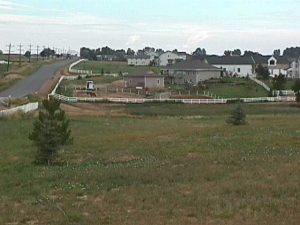Management Tools
Colorado is a wonderful place to live and each of us needs to do our part to keep it that way. As more individuals move to a small acreage setting, with a few or many acres to deal with, it is very important to provide you with guidelines and the tools to manage your dream acreage. The intent of this section is to provide you with the ability to evaluate what you have, give you the process to get you what you want out of your purchase, and some tools to get you where you want to be.
Look at What You Have
 Step 1- Document What You Have
Step 1- Document What You Have
his is the first step in developing a comprehensive management plan for your property. Get as much information as you can from all resources available to you. Now develop a planning map, and on this map sketch, write notes and show:
- Property boundaries – who are your neighbors and what they are doing on their property (farming, ranching, dairy, junkyard, etc.)?
- Utilities – both above and below ground and who provides these utilities.
- How the ground lays – direction and steepness of slopes and any out cropping (topographic map).
- Soil types – you can find this information by referring to your local county soil survey agency, maps are also available from the USDA Natural Resource Conservation Service office.
- Water features, if there are any present on your property. Ponds, streams, low wet areas or wetlands.
- Fence’s, corrals, buildings, roads, dumps, and underground storage tanks.
- Well’s (human or stock), abandoned wells – get a well analysis done by a local driller to know the depth to ground water, pump capacity, and flow rate of the well. Also, get a water analysis done from a local testing agency (call your local NRCS office, or Extension office to help you).
- Septic System – map the leach field and holding tank.
- Existing pastures.
- Livestock watering sites.
- Ditch easements.
- Map the weeds (species and location).
- Rare, and endangered species habitant.
- Land uses constraints, such as high water tables, flood potential.
- Access to your property.
- Check zoning building codes and other regulations that govern land use in your area.
- Financial means to do what you want.
- Time – how much labor can you invest?
- Equipment – tractor, sprayer, bush-hog manure spreader etc.
Set Vision Goals
Step 2 – Vision… Goals… Action Steps-
The best management plans: have clear visions, goals, and action steps.
- Vision – What are your dreams? A vision is a dream written down? Your vision needs to be a family dream. Sit down and come up with general statements of where all your efforts should go and what it will accomplish over a given time span (usually 5 to 10 years). A vision should be comprehensive enough to capture all your efforts.
- Goals – Less general than visions and describes what is needed to obtain the vision.
- Action Steps – Explains who is going to do what, where, and when. They generally articulate how to implement the goals. Don’t try and do to much at one time, just one step at a time.
These elements are blended together to come up with a management implementation plan from which your long range plan is set, for you and your family, on a step by step basis.
What Do You Want
Step 3– What are your goals and what do you want? What can your resources land, water, and air support? Ask yourself…
- Do we want animals, and how many will our resources support?
- Do we want to grow our own feed, such as alfalfa or grass?
- Do we want to create some wildlife habitat?
- Can we develop a fishpond?
- How do we start a 4-H project?
- Where do we put the riding arena, barns, and rotational pastures?
- Can we create some seclusion and wind protection with well-designed windbreaks?
- How will we lay out our house to enjoy the best views?
- How will we handle our non-irrigated pastures?
- Are our goals realistic for the resources that we have?
- Prioritize our action steps and have a realistic timeline.
- What grasses are best suited for our needs and wants?
- How, and with what, do we fence our pastures?
- How do we provide water for our animals?
- How about shade or shelter for our livestock?
- How do we plan for fire protection?
- What will we do about weed management?
- Should we use xeriscaping for landscaping?
Resources
Step 4- What are the resources that I can use to achieve our goals?
- Identify potential problems and opportunities.
- What objectives do I develop to achieve my goals?
- What resources are available?
- What are my options or alternatives
- Make a decision.
- Implement the plan.
- Evaluate the plan and all stages.
- Modify the plan as needed.



